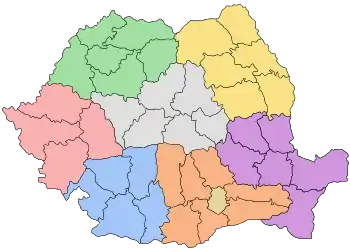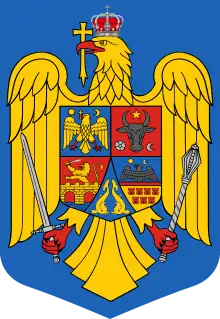Development regions of Romania
The development regions of Romania (Romanian: Regiunile de dezvoltare ale României) refer to the eight regional divisions created in Romania in 1998 in order to better co-ordinate regional development as Romania progressed towards accession to the European Union (EU). The development regions correspond to NUTS II-level divisions in EU member states. Despite becoming increasingly significant in regional development projects, Romania's development regions do not actually have an administrative status and do not have a legislative or executive council or government. Rather, they serve a function for allocating EU PHARE funds for regional development, as well as for collection of regional statistics. They also co-ordinate a range of regional development projects and became members of the Committee of the Regions when Romania joined the EU on January 1, 2007.

 |
|---|
|
List
There are eight development regions in Romania, which (with the exception of București-Ilfov) are named by their geographical position in the country:
- RO1 – Macroregiunea 1:
- RO2 – Macroregiunea 2:
- RO3 – Macroregiunea 3:
- Sud - Muntenia – RO31; 7 counties; 3,136,446 inhabitants; 34,489 km2 (13,316 sq mi)
- București - Ilfov – RO32; 1 county and Bucharest; 2,272,163 inhabitants; 1,811 km2 (699 sq mi)
- RO4 – Macroregiunea 4:
- Sud-Vest Oltenia – RO41; 5 counties; 2,075,642 inhabitants; 29,212 km2 (11,279 sq mi)
- Vest – RO42; 4 counties; 1,828,313 inhabitants; 32,028 km2 (12,366 sq mi)
Economy
| 2006 | 2016[1] | |||||||||
|---|---|---|---|---|---|---|---|---|---|---|
| Region (NUTS) |
Total (million €) [2] |
€ per capita [3] |
PPP (million €) [4] |
PPP € per capita [5] |
% of EU average GDP (PPP) [6] |
Total (million €) |
€ per capita |
PPP (million €) in 2014[7] |
PPP € per capita |
% of EU average GDP (PPP) |
| Romania | 98,419 | 4,500 | 196,999 | 9,200 | 38 | 169,771 | 8,600 | 301,801 | 17,000 | 58 |
| Nord-Vest | 11,675 | 4,200 | 23,370 | 8,700 | 36 | 19,519 | 7,600 | 34,001 | 14,300 | 51 |
| Centru | 11,335 | 4,500 | 22,689 | 9,100 | 37 | 18,761 | 8,000 | 33,349 | 15,800 | 54 |
| Nord-Est | 10,787 | 2,900 | 21,591 | 5,900 | 24 | 17,081 | 5,300 | 30,912 | 10,400 | 36 |
| Sud-Est | 11,051 | 3,800 | 22,119 | 7,900 | 32 | 18,159 | 7,400 | 34,020 | 14,600 | 52 |
| Sud - Muntenia | 12,482 | 3,800 | 24,985 | 7,700 | 31 | 20,583 | 6,800 | 36,630 | 14,200 | 46 |
| București - Ilfov | 22,946 | 9,900 | 45,931 | 21,100 | 86 | 46 994 | 20,500 | 81,267 | 40,400 | 139 |
| Sud-Vest Oltenia | 8,138 | 3,600 | 16,290 | 7,200 | 29 | 12,451 | 6,300 | 22,677 | 12,400 | 42 |
| Vest | 9,940 | 5,300 | 19,897 | 10,500 | 43 | 16 081 | 8,900 | 28,698 | 17,600 | 60 |
See also
References
- "Statistics". ec.europa.eu. Retrieved 2019-05-17.
- "Site3-TGM table". Epp.eurostat.ec.europa.eu. Retrieved 2009-07-14.
- Eurostat (19 February 2009). "GDP per inhabitant in the EU in 2006" (PDF). Europa web portal. Retrieved 28 February 2016.
- "Site3-TGM table". Epp.eurostat.ec.europa.eu. Retrieved 2009-07-14.
- "Site3-TGM table". Epp.eurostat.ec.europa.eu. Retrieved 2009-07-14.
- "Site3-TGM table". Epp.eurostat.ec.europa.eu. Retrieved 2009-07-14.
- Eurostat (26 February 2016). "GDP per capita in the EU in 2014". Europa web portal. Retrieved 28 February 2016.